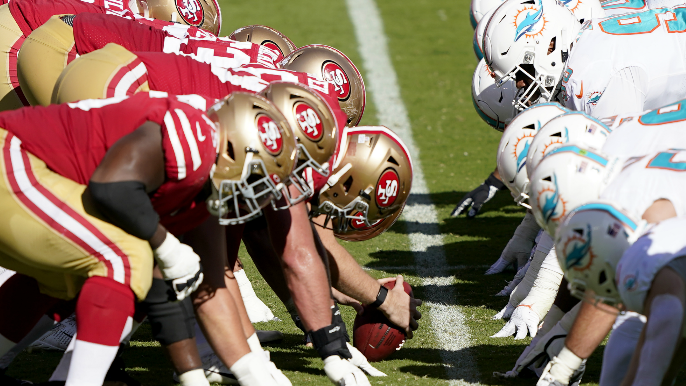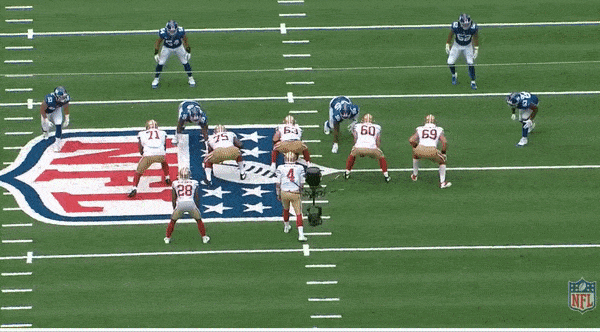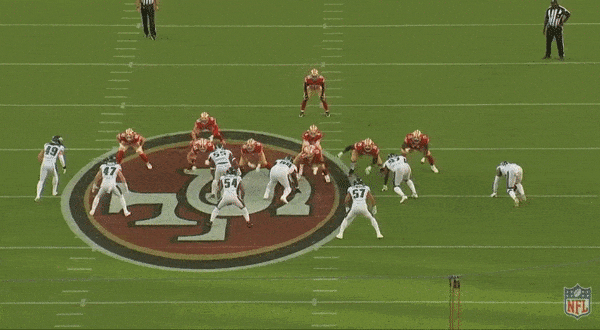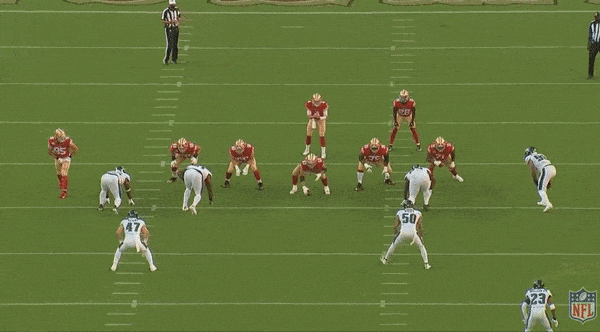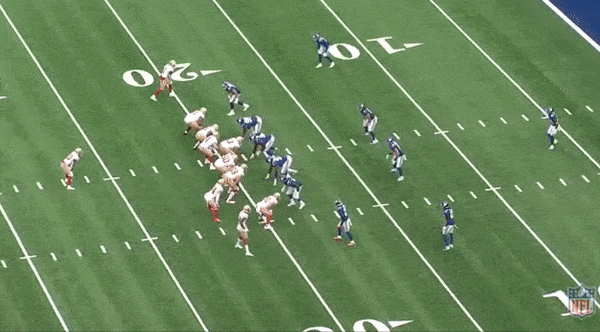Photo by Thearon W. Henderson/Getty Images
On Wednesday, Mike McGlinchey responded to his critics—”armchair quarterbacks,” he called them—in no uncertain terms. The third-year offensive tackle, who is in a crucial year, needing to prove himself to get his fifth-year option picked up by next May, was on the defensive.
He acknowledged he can’t give up plays like the one below against the Philadelphia Eagles, in which he “went a little too heavy at the guy” and allowed a quarterback hit on Nick Mullens turned interception.
The first Nick Mullens INT. Watch Mike McGlinchey #49ers pic.twitter.com/Ggeupj7kdP
— Jake Hutchinson (@hutchdiesel) October 5, 2020
“It can’t happen,” McGlinchey said.
But he wasn’t happy with his critics, claiming that he’s, “… been putting together a pretty good season and I keep continuing to get better each week,” and that the idea he’s been poor is a “lazy narrative” created by people who have not watched him play.
“I think that each week it’s gotten better and better,” McGlinchey said. “I think that the things that you have been saying have been a little bit over the top. I think nobody’s watching a complete football game and they’re choosing a lazy narrative of one play and they see something on Twitter and they think they have it figured out, but no, I think it’s been a solid, solid year.
“Obviously have a lot of things continue to improve on, but I’ve been doing that week to week, and just have to clean up.”
Having re-re-watched every 49ers game from this season, looking at every single offensive line snap, the criticism is fair. The idea that McGlinchey has actually had a good season, but made one or two errors that have been unfairly highlighted, is simply untrue.
What the tape shows is a thinner McGlinchey—who admitted he lost weight this offseason, saying the number was roughly five pounds—struggling to anchor himself against power rushes.
This is not to say the offensive line or the offense’s struggles as a whole rests solely on McGlinchey’s shoulders. There have been egregious failures at times from every offensive lineman on this team, and the blocking from tight ends—yes, George Kittle—wide receivers and Kyle Juszczyk has regressed from last season, or at the very least failed to find that same form.
There are inconsistencies all throughout this offense in terms of run blocking and protection, the latter of which also sits on the shoulders of the quarterbacks. It also rests with the play caller in head coach Kyle Shanahan, who has attempted to run the same offense with personnel discernibly not fit for it.
Missed protections, miscommunicated protections, potential blitzers not being identified pre-snap, double-team blocks failing, help blocks not getting there quick enough, basic stunts resulting in consistent pressures; all these things have manifested at the same time, and there is plenty of blame to be doled out to every member of the offense.
But blocking, as you may well know, is the sole job of the offensive line. And every offensive line is judged by its mistakes, not its successes, the latter of which will always outnumber the former. And through five games, mistakes have been prevalent on this offensive line.
The following numbers are based on my own review of the film.
Pass protection
As you would expect, Trent Williams, even though he’s had two moments where he didn’t know what protection the team was in, has been far and away the best pass protector on this line. By my count, he’s allowed 2.5 quarterback hits and 5.0 pressures (being defined as any time the quarterback has to adjust due to pressure allowed by the blocker, or the throw or vision are affected). He has allowed 3.0 sacks. He’s yet to find comfortable footing in this offense, in large part due to a discernible lack of cohesion with Laken Tomlinson, but he’s clearly not the problem.
It’s not a one-week issue with Trent Williams. He’s getting the protections wrong #49ers pic.twitter.com/oIDt56Hr6U
— Jake Hutchinson (@hutchdiesel) October 12, 2020
Laken Tomlinson and Williams are clearly not on the same page. One of the sacks allowed this season, against the Eagles, was due to the fact that Tomlinson attempted to provide a help block to Williams, who was having no issues with Josh Sweat and instead pushed Sweat backwards, towards the pocket, leaving Nick Mullens and Williams out to dry. This was clearly what the play called for, but Tomlinson didn’t have the presence of mind to realize that the “help block” he’d be providing had him sending the rusher in the wrong direction.
(You’ll also see Ross Dwelley struggle in pass protection here, which has been all too common):
He’s allowed the most sacks on the team, with 4.0; a disproportionate figure to the number of pressures (6.5) and QB hits (5.0) he’s allowed. Tomlinson’s few beats have been ugly, frequently against power rushers who counter against his weight with a rip move. When he doesn’t get his feet stuck in mud, he rarely loses one-on-ones, but it’s those first two steps when he has a propensity to whiff and get beaten quickly.
Ben Garland is very clearly not the player he was last season, and an ankle sprain he seems to have returned from too quickly is the most immediate source. He most frequently gets beaten on rip moves. When he’s moving on a slide protection, or especially play action, he most often struggles with counters going against the flow of the play. His balance is poor and because of that, he’s an easy target. His struggles have been more borne out in the run game and downfield play-action pass blocking than in traditional pass protection.
Daniel Brunskill is the worst offensive lineman on this team right now, and if something drastic doesn’t change, his job is in jeopardy. He played right guard twice last year, but he looks lost at his relatively new position, which is stunning given how well he performed at tackle, and the fact that he played guard successfully last year against the Rams and Seahawks.
He has allowed far and away the most pressures (14.5) and quarterback hits (11.5), and 3.0 sacks, one of which resulted in that sack fumble on Nick Mullens against the Eagles. And unlike most of the other players in this group, it’s not one thing that’s gone wrong for Brunskill; it’s everything. He’s whiffing early, getting beaten on speed and power late.
Daniel Brunskill has yet to look comfortable at right guard this season. Was beaten on the sack fumble on a safety blitz pic.twitter.com/oehfubIdsu
— Jake Hutchinson (@hutchdiesel) October 8, 2020
Mike McGlinchey has been the second-worst pass blocker, after Brunskill, despite his comments that would suggest otherwise. Again, it’s the power rushers who are doing it. He’s handling speed better than he was last year, which seems to have been a concerted effort with that weight loss, but he frequently struggles to anchor against heavier rushers.
One stat that hasn’t been mentioned is how many times a player has been knocked over. Effectively, it’s a defensive pancake, not including times when linemen trip on each other. McGlinchey has been knocked over/defensively pancaked seven times. Daniel Brunskill is second, with three defensive pancakes.
This is probably the most damning part of the night for McGlinchey. Avery bullies him and then Graham swipes around him on back-to-back plays, forcing Beathard to preserve the drive and then the Hail Mary to end it for #49ers https://t.co/weA9gbxcx7 pic.twitter.com/JrnxL7sjSE
— Jake Hutchinson (@hutchdiesel) October 5, 2020
McGlinchey has allowed the second-most pressures (11) and quarterback hits (11), and while he’s only been credited with one sack allowed by Pro Football Focus, I observed another half sack and consider the whiffed block-turned-interception worthy of counting as a sack, bringing his tally to 2.5. He and Brunskill have each been straight-up beaten in one-on-ones eight times each.
It’s not hyperbolic to say that he’s been a liability in pass protection. Being solid on 9 out of 10 snaps does not make you a good pass blocker when that one snap is getting thrown to the ground. Williams built his reputation on not allowing pressures, let alone sacks. McGlinchey is nowhere close to that right now.
Also, this isn’t new. McGlinchey had this happen last year.
McGlinchey gets beaten badly for the sack and Person trips when pulling on the 2nd INT (though it looked like he or Breida missed an assignment regardless) pic.twitter.com/oSEeCeSpv4
— Jake Hutchinson (@hutchdiesel) September 28, 2019
This isn’t just my assessment.
Per Pro Football Reference, the 49ers have allowed 31 quarterback hits, the most in the NFL. They have a 30.3 percent pressure percentage allowed (worst in NFL), 59 total pressures (3rd-worst) and 18 sacks (4th-most).
Run blocking
Trent Williams
There isn’t too much to complain about with Williams’ run blocking performances. He’s missed four run blocks, but that’s the fewest on the team (McGlinchey has the second-fewest with five). Against the Eagles, he sometimes struggled to get his mark quick enough and was pushed back into the path of the run, but a lot of that was the Eagles consciously diving against the zone blocking scheme the 49ers mostly used and putting their blockers in bad positions. He’s had two penalties in the run game, which leads the team, but other than that, he’s been reliable.
Laken Tomlinson
One thing that was tracked here was how many times a player failed to hold their block long enough, and it resulted in a tackle or contact to the rusher. Tomlinson leads the 49ers in that category, with eight times his block wasn’t held long enough. Daniel Brunskill was second, with that happening four times. It’s a bit of a bizarre sight, given that Tomlinson was such a reliable force in the run game last year, but he’s not getting the leverage required with any sort of consistency this season.
The clip below shows all the offensive line problems plaguing this team this year. Tomlinson doesn’t get the initial push required, gets leverage on the wrong shoulder and can’t hold his block long enough. Brunskill gets beaten from the jump, and Garland misidentifies his second-level block (this example is more excusable than most for Garland, because he expects the safety to be his assignment, and the Jets play it well, but he clearly doesn’t have the agility required to change his course).
Ben Garland
Garland clearly is not right, and Shanahan mentioned this week that he’s been battling through the ankle sprain, which it seems he may have returned from too soon.
“Ben Garland has been going through it for a while,” Shanahan said. “He came back from it after having a month off and you can see on some plays his first week that he really struggled because of it. You could see it in the second week. You still see it at times.”
He consistently struggles to get to the second level and make blocks, an area which was one of his strengths last season. It was evident on this play in particular, against the Eagles, where he looks hobbled and can’t change direction remotely quick enough to attempt to pick up a defender at the second level. It’s not unreasonable to wonder whether Hroniss Grasu should have been given the start against the Jets. Grasu struggled in training camp, but didn’t miss a run block or allow a pressure to the Cardinals.
Daniel Brunskill
As shown in the Jets clip above. Brunskill just gets bullied far too often. He’s missed the most run blocks of any lineman on this team, with 11. The next-closest is Garland, with eight, which makes them close to even given Garland was absent for the season opener. Both have missed five second-level blocks, and Tomlinson’s missed four.
This run game relies, at its core, on interior linemen nailing their run blocks and getting to the second level effectively. That isn’t even close to the case, and it’s why, before Raheem Mostert returned to bail out some of that poor play, they allowed a league-leading 21 negative run plays.
Here’s the running game at its worst:
Tomlinson throws a rusher into Williams, Brunskill gets bullied, almost blowing the run up in the backfield, McGlinchey gets turned in the wrong direction, and Ben Garland completely whiffs on a second level block. You’ll even see George Kittle fail to finish his block like he almost always did last year. Everything is sloppy and exceedingly slow.
Somehow, Jerick McKinnon turned this into a 15-yard gain. In a way, McKinnon is like J.R. Smith. The more difficult an opportunity is, the more off-schedule it is, the more likely it is he thrives in it. But that’s the opposite of what this offense’s success is predicated on.
Mike McGlinchey
Perhaps the reason McGlinchey was so protective of his performances is that he’s an excellent run blocker, and though he’s missed five blocks this year, he’s otherwise been stellar. But without being a reliable pass blocker, he’s become, in essence, a talented, oversized, blocking tight end.
This offense, at its best, or at least close to it, looks like Brandon Aiyuk’s 38-yard touchdown below. He has to do some work to avoid tackles, but Brunskill and McGlinchey set key downfield blocks to give him the space to break it free.
Brandon Aiyuk with a hurdle for a touchdown!pic.twitter.com/l8w2zMJ6Mg
— Football Analysis (@FBallAnalysis) October 5, 2020
It also looks like this below, again with the ball in Aiyuk’s hands behind the line of scrimmage. Everyone seals their blocks to the left, Kyle Juszczyk deceives that the play is going left, and then he, Garland and McGlinchey, all secure their second-level blocks for the touchdown. Those are the fundamental, dominant things this team has to get back to, especially if it hopes to beat the Los Angeles Rams on Sunday.
Again, this is not to say the team’s struggles have entirely been the fault of the offensive line. The wide receiver blocking has been woeful when compared to last year, and Ross Dwelley as the team’s second tight end is not a viable blocking strategy. Kittle looks like a man who’s dealing with the attrition that comes with playing through multiple knee injuries and bone chips and bruises, and Juszczyk hasn’t had the same force as a blocker, especially in tight spaces around the line of scrimmage.
But the offensive line has unquestionably been a massive issue for this team. The interior run blocking is lacking power and the ability to consistently secure second-level blocks, and the pass blocking from everyone not named Trent Williams, especially from Brunskill and McGlinchey, is a liability so far this season.


